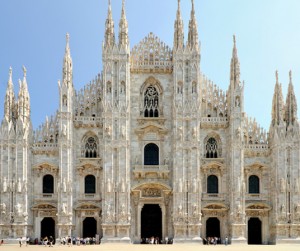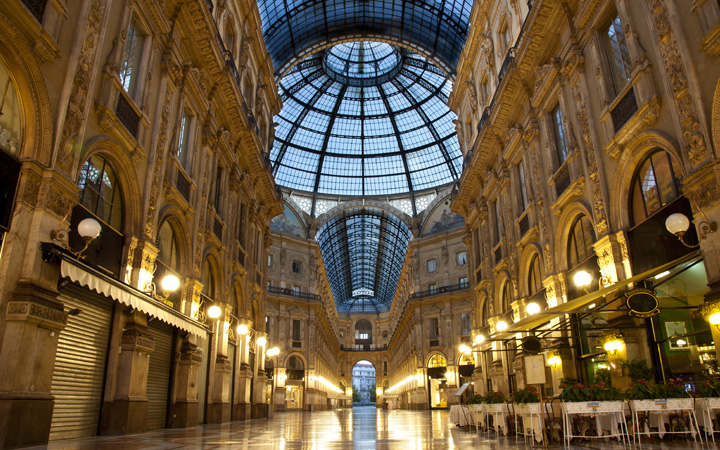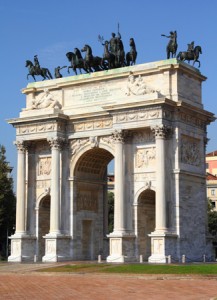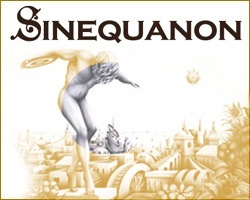Charles Dickens al suo ingresso a Milano in una giornata fitta di nebbia, raggiungendo quella che é da sempre l’icona della città più nota nel mondo, annotava fra l’altro…”la nebbia era così fitta che il pinnacolo del famosissimo Duomo, per quel che si riusciva a scorgerne, poteva anche trovarsi a Bombay” . Egli faticò non poco infatti, in quella atmosfera così ovattata, a riconoscere il profilo “di quella gran macchina del Duomo “sola su un piano”, come se non sorgesse al centro di una città, ma in mezzo ad un deserto.
E uno strano commento, solo qualche decennio più tardi, sarà quello del francese André Suarès, che definiva Milano come “una città a forma di ruota…un tondo formicaio, la città più cinese d’Europa”….la stazione é un tunnel di vetro splendente …L’intera città non è che una stazione. Il tumulto, il movimento secco dei binari si ritrova ovunque nelle strade; e quel duomo di marmo é una stazione, di marmo”. E ancora Henry James visitando il Duomo nel 1877, lo menziona come “la pagina più densa e interessante” del volume che narra la storia di Milano. Tutti i viaggiatori stranieri comunque hanno fatto grandi descrizioni del Duomo, affascinati dalla sua imponente facciata dal “taglio triangolare” culminante con gli infiniti pinnacoli.
E la Madonnina, protettrice dei milanesi continua a destare interesse e a sollecitare studi ed esposizioni che ne narrano la nascita, come quella che ha mostrato il busto ligneo originario da cui è stata forgiata la sua statua dorata e la struttura in ferro che la sosteneva, poi sostituita da una più resistente struttura in acciaio.
Molte sono le parti della Cattedrale che necessitano di un restauro urgente e, per questo, la Fabbrica ha attuato una strategia per la ricerca delle risorse, dando vita a diverse iniziative artistiche e culturali, nell’ambito di “VivilDuomo”, in cattedrale e sulle terrazze, per sensibilizzare l’opinione pubblica e ricreare la partecipazione attiva alla vita del monumento, simbolo di Milano nel mondo. Di grande attrattiva é stata ad esempio l’iniziativa di accogliere i concerti fra le guglie (ben 134 e tutte numerate in senso orario), per sostenere i restauri di alcune parti del Duomo e anche di una delle guglie.
Ma sono tanti gli Eventi che legano Milano alla grande Storia, dall’anniversario dell’Editto di Costantino (2013) all’Expo 2015.
E la città si prepara a quest’ultimo evento a cominciare dal raffinato restauro della Stazione Centrale, rimasta con la sua poderosa facciata a stigmatizzare tanti storici arrivi in città, ma completamente rinnovata in tutto il suo apparato ricettivo e funzionale. Nell’ambito del progetto nazionale “Grandi Stazioni” il nuovo concept, nel pieno rispetto dell’identità storica e architettonica della stazione, ha posto al centro un modello innovativo di gestione dei flussi. Sono state riorganizzate le percorrenze interne e il sistema dell’accessibilità, riposizionando e riconfigurando un piano di interventi basato sull’utilizzo di tecnologie avanzate in relazione alle aspettative della clientela attuale, per innalzare il livello di qualità, comfort e sicurezza.
Ma ecco anche una Milano letteraria, attiva da tanti anni ad esempio attorno al “Bagutta”, il ristorante frequentato da artisti, scrittori e giornalisti e “citato” su testi e dizionari, come in quello di Alfredo Panzini (Dizionario Moderno), che lo menziona per essere stato la sede del Premio fondato nel 1927 da giornalisti ed artisti, per aiutare il parto di geni giovanili”. Primo istituito in Italia, il premio é annualmente assegnato ad un’opera di scrittore italiano contemporaneo da una qualificata giuria e viene considerato un “premio aristocratico”, assegnato d’inverno e cioé “quando Milano ha la nebbia o la neve e la piccola via parallela alla Montenapoleone consente qualche rapido transito di fantasmi come Panzini o Pirandello..”
Ma i Milanesi frequentano anche i locali caratteristici della città sull’acqua, lungo gli storici Naviglio Grande e Naviglio Pavese, testimoni di una Milano che si é sviluppata a suo tempo su una rete di corsi d’acqua, che consentiva il trasporto fra il Ticino, l’Adda e il Po e, quindi, il mare Adriatico. E oggi i laboratori artigianali e gli antichi lavatoi, coperti di tetti di legno vivono nei locali caratteristici che l’Associazione Naviglio Grande tutela nelle caratteristiche storiche e ambientali, con milioni di visitatori e turisti.
Ma come non fermarci sull’altra, storica “icona” di Milano: il Teatro alla Scala, che l’architetto Botta ha ristrutturato fra il 2002 e il 2004, pur lasciandone inalterata la facciata, e non dare un rapido sguardo alla città del futuro, la grande metropoli del “dopo 2015” .
Eccola, già svettante, la Torre Garibaldi di Cesar Pelli, che, con i suoi 230 metri ha superato la sede della Regione di I.M.Pei, alta “soltanto” 161,3 metri, ma che vedrà presto erigersi la torre del CityLife dell’americano Libeskind, con i suoi 150 metri, cambiando totalmente il profilo urbano della vecchia Milano.
 MILAN from the history to the 2015 Expo
MILAN from the history to the 2015 Expo
Words by Luisa Chiumenti
When Charles Dickens entered Milan on a foggy day, coming to the most famous and eternal icon of the city, he noted, among other things….”it was so foggy that given what one could see of the spire of the famous Cathedral, it could easily have been in Bombay.” In fact it was not easy, in that muffled atmosphere to recognize the silhouette of “that great machine of the Cathedral “just on one plain, as it if were not standing in the centre of a city but in the middle of a desert.”
It a strange remark, dating to some centuries later, is that of Frenchman André Suarès, who called Milano “a city shaped like a wheel…a round anthill, more a Chinese than a European city…..the station is a splendid glass tunnel……The city centre is one big station. The turmoil, the dry movement of the tracks are everywhere in the streets: and that marble cathedral is a marble station.” And then there was Henry James, who visited the cathedral in 1877, referring to it as “the most dense and interesting page” of the book that tells the story of Milan. But many international travellers have given great descriptions of the cathedral, falling under the spell of its striking “triangular-cut” facade culminating with the endless spires.
And the statue of the Madonnina, the patron of the inhabitants of MIlan, still attracts attention and continues to be the subject of studies and exhibitions that tell the story of how it came to be, of how the person who showed the original wooden bust from which his golden statue was forged and the iron structure on which it stood, which was then replaced by another, stronger steel base.
Many parts of the cathedral are urgently in need of renovation and this is why the Fabbrica has launched a drive to find funding, through various artistic and cultural initiatives which are part of the “VivilDuomo” project in the cathedral and on the terraces, the aim being to sensitize public awareness and get people involved once again in the reality of this monument which the world sees as the symbol of Milan. One idea that has attracted a lot of attention is the idea of organizing concerts high up among the spires (there are 134 of them and they are all numbered anticlockwise) to fund the restoration of some parts of the cathedral and the spired themselves. But many events link Milan to history from the anniversary of the Edict of Constantine (2013) to the 2015 Expo.
And the city is getting ready for the Expo, starting with some refined restoration on the main railway station, the Stazione Centrale, the powerful facade witness to so many historical arrivals to the city, and which has been given a real facelift with regard to passenger services and facilities. In the framework of the new “Grandi Stazioni” project the new concept, while respecting the historical and architectonic identity of the station, has given priority to an innovative model of traffic management. The internal passageways have been reorganized as have the access areas, repositioning e reconfiguring a plan based on the use of cutting-edge technology in relation to the expectations of current users, with an aim to then boosting the levels of quality, comfort and security.
And then there is literary Milan, which as been alive for many years, for example around the Bagutta, the restaurant which has long been a haunt for artists, writers and journalists and is mentioned in many texts and dictionaries like the Alfredo Panzini (Dizionario Moderno), which mentions it as having been the seat of the Prize founded in 1927 by journalists and artists to help the birth of “youthful geniuses.” Launched in Italy the prize is awarded every year by a jury to the work of a contemporary Italian writer, and is considered an “aristocratic prize,” awarded during the winter months when Milan has snow and fog and along the little street parallel to Via Montenapoleone ghosts like those of Panzini or Pirandello flit past….”
But the Milanese also frequent the typical bars and club of the water city along the historical Naviglio Grande and Naviglio Pavese, which bear witness to a Milan that, in the past, developed on a network of waterways which made it possible to navigate between the Ticino, the Adda and the Po and then also the Adriatic. And today the old artisan shops and ancient washhouses, with their wooden roofs, are now part of the Naviglio Grande Association, which protects historical and environmental premises, and attract millions of visitors and tourists.
And then there is that other historical icon of MiIan, the La Scala Opera House which the architect Botta rebuilt between 2002 and 2004 leaving the façade as it was, and then there is the Milan that looks towards the city of the future and the great post-2015 metropolis.
And, of course to Cesar Pelli’s Garibaldi Tower which, with its 230 metres, soars higher than I. M. Pei’s building which is the headquarters of the Region, and stands at a mere 161.3 metres but will soon see the CityLife Tower, designed by the American architect Libeskind, soar to 150 metres, totally transforming the urban silhouette of old Milan.




